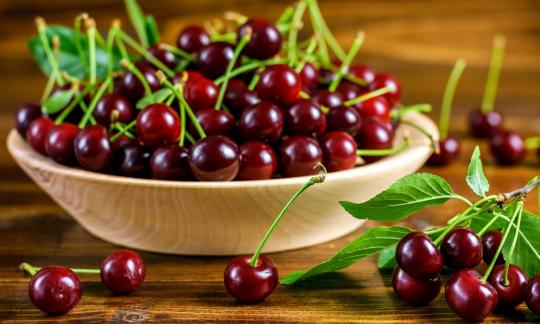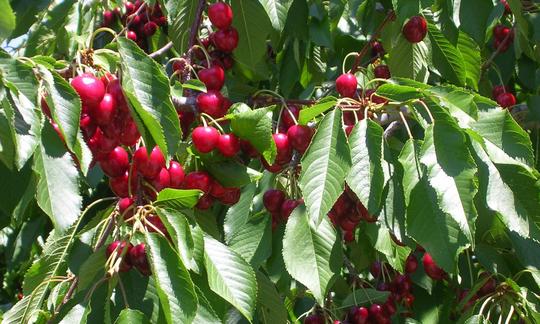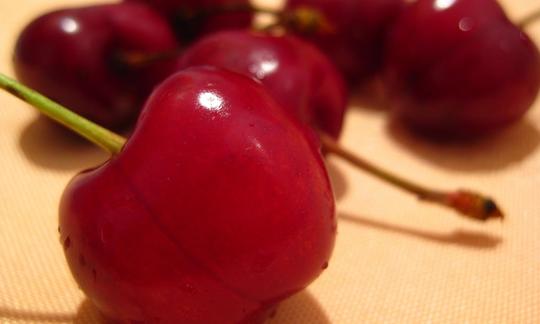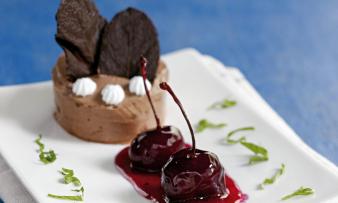Table of contents
The sour cherry ( Prunus cerasus ) is also known as the sour cherry . This edible stone fruit, also known in some places as the sour cherry , has a characteristically sour taste in contrast to the fruity sweetness of the cherry or sweet cherry .
Use in the kitchen:
Sour cherries are characterized by their high fruit acid content and the resulting sour taste. The red fruit only tastes good when fresh and raw when it is fully ripe, but this also depends on the variety. Sour cherries become much more important when combined with sugar. Industrially processed sour cherries in particular are very popular as pickled cherries, compotes, jams (marmalades) or juices. The dairy industry also uses sour cherries to make yoghurt or quark desserts.
Fresh cherries are suitable for a variety of cakes, mousses , strudel, muesli, ice cream or smoothies. One of the most famous desserts is probably the Black Forest gateau with sour cherries.
Dried sour cherries can be found in ready-made muesli mixes or as dried fruit. The raw fruit and the juice are particularly beneficial to health.
Vegan recipe for sour cherry and nut cake:
Ingredients: 170 g vegetable margarine , 140 g brown sugar , 1 banana , 100 g ground hazelnuts , 40 g chopped walnuts , 200 g pitted sour cherries (possibly from a jar), 150 g spelt flour , 1 teaspoon cream of tartar baking powder , 1 teaspoon cinnamon powder , 50 ml rice milk , 100 g chopped dark chocolate , margarine for the mold.
Preparation: Preheat the oven to 180 °C top/bottom heat. Mix the margarine and sugar in a bowl and mix with the mashed banana. Chop the walnuts and half of the chocolate and mix in with the ground hazelnuts. Mix the sifted flour with the baking powder and cinnamon and add. Finally, stir in the rice milk well. Pour the dough into a greased springform pan and spread the drained sour cherries evenly on top. Then put it in the oven and bake for approx. 45-50 minutes. After it has cooled, melt the remaining chocolate in a water bath and spread it over the cake. Alternatively, you can just sprinkle it with powdered sugar .
Recipe for sour cherry and vanilla jam:
Ingredients: 1 kg sour cherries, 1 kg gelling sugar, 1 vanilla pod .
Preparation: Wash and pit the cherries. After draining, place in a large saucepan and mix well with gelling sugar. Cut open the vanilla pod, scrape out the pulp and add it, including the pod, to the cherry-sugar mixture. Bring the fruit to the boil while stirring constantly and let it simmer for a few minutes. Stir constantly. Remove the vanilla pod and pour the hot jam into clean screw-top or Weck jars. Alternatively, you can finely puree the sour cherry jam with a hand blender and then bottle it. Turn the tightly sealed screw-top jars (not the Weck jars!) upside down for 5 minutes. Then wipe the rims well, label them and store in a dark, cool place.
Vegan recipes with sour cherries can be found under the note: " Recipes that have the most of this ingredient ".
| Not only vegans or vegetarians should read this: Vegans often eat unhealthily. Avoidable nutritional mistakes . |
Shopping - where to buy?
Fresh sour cherries are rarely available from major retailers such as Coop , Migros , Denner , Volg , Spar , Aldi , Lidl , Rewe , Edeka , Hofer etc. You usually find them pitted as compote in glass jars, rarely in cans, with water and mostly sugared. Organic sour cherries in jars are available from organic supermarket chains such as Alnatura and Denns . These are also available unsweetened.
Fresh sour cherries are available during the season (June to mid-August) at weekly markets, in selected supermarkets (mostly with a regional focus) and in some places also from small roadside stands.
Storage:
Fresh sour cherries are very sensitive and should be consumed quickly to avoid any loss of quality. The sour cherries should only be washed and pitted shortly before further use, otherwise they will lose their aroma. If you want to freeze the cherries, you should drain them after pitting them, place them on a tray and pre-freeze them briefly. Only then should you put them in a freezer bag and freeze them completely. This way the fruits can be removed individually and will not stick together.
Cherries do not ripen, which is why it is best to only pick them when they are fully ripe. Sour cherries will stay edible for around 10 days at 0-2 °C.
Found in the wild:
Sour cherry trees often grow wild in hedges, vineyards or in open oak forests, but no true wild forms are known. 1
Ingredients - nutritional value - calories:
Sour cherries have around 50 kcal per 100 g. 12% of this is carbohydrates, of which around 8.5% is sugar and 1.6% is fiber. Proteins and fats are hardly present in this fruit, but the water content is over 86%. 2
Although this type of cherry tastes so sour, this has little to do with the ascorbic acid it contains. The vitamin C content is only 10 g/100g of cherries. Apricots and avocados have the same values. Strawberries are a good source of vitamin C as fresh fruit, with around 59 g/100g. Kiwis also provide a lot of the important antioxidant, with 93 mg. 2
Potassium is an essential element that is found in many foods. In terms of potassium content, sour cherries with 173 mg/100g are on a par with sage or similar to green bell peppers . Dried herbs have a lot of potassium ( dried parsley : 2680 mg/100g), but lamb's lettuce (460) and bananas (360 mg/100g) also have significant amounts. 2
The vitamin A content of sour cherries is identical to that of passion fruit at 64 µg/100g. The fat-soluble vitamin is usually present as provitamin A in the form of carotenoids in plant-based foods. Carrots, for example, have a very high vitamin A content of 835 µg per 100g of vegetables. But green broccoli leaves are also astonishing at 800 µg/100g. 2
In addition to various B vitamins, folic acid is also worth mentioning.
The complete ingredients of the sour cherry, the coverage of the daily requirement and comparison values with other ingredients can be found in our nutrient tables. In the article Nutrients explained you will get a detailed insight into the topic.
Health aspects - effects:
Why are cherries healthy? Plants with red, purple, blue or blue-black fruits contain anthocyanins. These water-soluble plant pigments have bioactive properties in addition to their coloring power. They have antioxidant and anti-inflammatory effects. 3 In addition to the anthocyanins, other flavonoids such as catechin, quercetin and kaempferol are also included, which also protect against free radicals, bacteria and viruses. They are also said to prevent heart disease and tumors. 4
The anthocyanins contained in the fruit are said to have a positive effect on bone density and thus prevent osteoporosis. These plant pigments are also said to have a preventive effect against stroke. Experiments with sour cherry extract and essential fatty acids as well as extracted sour cherry anthocyanins also show positive effects against Alzheimer's. 5,6
The antioxidant chlorogenic acid is said to inhibit the absorption of sugar in the blood and thus counteract diabetes and lower blood pressure. In addition to cancer, chlorogenic acid is also said to reduce the risk of cardiovascular disease. 7 It is not clear whether this ester of caffeic acid really helps against stomach or liver inflammation.
How healthy is sour cherry juice? Studies show that the juice of sour cherries (especially the Montmorency variety) can reduce muscle soreness and fatigue during excessive exercise. 8 In addition, the body can absorb the bioactive components better from the juice than from the plant tissue. 9
Sour cherries are said to help with sleep disorders because they increase melatonin levels. 10 The natural hormone melatonin plays a role in controlling the sleep-wake cycle. The natural melatonin contained in sour cherries with up to 13.5 ng/g is therefore said to counteract a deficiency. The melatonin content can vary greatly depending on the variety. 11 Eating small amounts of cherries every day can increase the melatonin level in the blood. 12
The fruit acids contained in sour cherries not only have an alkaline effect but also have a positive effect on the digestive system and accelerate the metabolism. 13
Dangers - Intolerances - Side effects:
Neither sweet nor sour cherries are recommended for people with fructose intolerance. Although sour cherries taste significantly less sweet, 100 g still contain around 4 g of fructose, while sweet cherries contain 6.3 g/100g. Depending on sensitivity, an amount of 1 to 10 g of fructose can cause symptoms such as a feeling of fullness and flatulence, as well as cramp-like pain and diarrhea.
If you have gastrointestinal problems, the high fruit acid content of sour cherries can cause discomfort. In this case, you should prefer fruit that is low in fruit acid, such as bananas , mangos or pears .
Use as a medicinal plant:
The bark, leaves, flowers, seeds and resin of cherry trees were once used for medicinal purposes. The bark and leaves contain not only tannins, but also hydrocyanic acid glycosides (hydrocyanic acid glycosides). The cherry seeds contain a much higher content of poisonous amygdalin. 14
The fruits are astringent, blood-forming and diuretic. The cherry stems are also said to be good for stubborn coughs and have a diuretic effect. 14
Folk medicine - naturopathy:
Regular consumption of cherries of all kinds is said to ward off chronic diseases such as arthritis, gout, rheumatism, arteriosclerosis, constipation, liver diseases, etc. 15
Occurrence - Origin:
Sour cherries come from the Middle East, but grow in almost the entire northern hemisphere. In Finland they can be found up to 63 degrees latitude and in Norway up to 68 degrees latitude. In some cases sour cherries grow up to 1800 m above sea level. 1
Cultivation - Harvest:
As a shrub or tree, the sour cherry reaches heights of up to 10 meters. It grows on loose, light, nutrient- and base-rich, sandy loam soils. Its flowering period is from April to May. 14 The edible stone fruits measure approx. 15-20 mm, are more or less spherical, only slightly higher than they are wide; the flesh is red or uncolored. The harvest time is from June to mid-August. 16
The larvae of the cherry fruit fly ( Rhagoletis cerasi ) mainly attack sweet cherries ( Prunus avium ), but sour cherries ( Prunus cerasus ), honeysuckle ( Lonicera ), snowberries ( Symphoricarpos ) and black cherry ( Prunus padus ) are also sources of food. In conventional fruit growing, the use of insecticides is therefore seen as indispensable, even though Greenpeace classified these pesticides as "particularly harmful to health" in 2009. In organic farming, on the other hand, attempts are made to keep the larvae under control with close-meshed nets, insect-damaging nematodes and fungi. 17
Wikipedia gives harvest figures for sour cherries of around 18,000 tonnes (2011). 16 Due to the difficult conditions, the share of organic cherry areas in Germany in 2012 was not very large at 1,200 hectares. Variety trials and biological pest control trials are intended to help increase the market share of organic produce. 17
Subspecies:
According to Wikipedia , the subspecies are the tree sour cherry and the shrub sour cherry.
The sour cherry tree ( Prunus cerasus subsp. cerasus ) is divided into two varieties: 1
- The glass cherry, water cherry or amarelle ( Prunus cerasus var. cerasus ) with light red, glassy and sour fruits, the stone is difficult to separate from the stem.
- The sweet cherry, Morello ( Prunus cerasus var. austera L.) has red, sweet and sour fruits with colored juice. The stone comes off the stem very easily.
The sour cherry, also known as Morello cherries ( Prunus cerasus subsp. acida ), grows as a shrub or small tree. The dark red, sour fruits have a colored juice. This species forms root runners. 1 Morello cherries are very popular cherries because they are considered to be very undemanding plants and even when grown in the shade they produce many blackish-red cherries.
Growing and harvesting in the garden:
The ideal variety for growing in your own garden depends very much on personal preferences and the garden conditions. There are numerous early, medium and late ripening varieties of sour cherries. When choosing a variety, you should also pay attention to the trees' susceptibility to disease. Some varieties are very intensely sour, but there are also sour cherries that contain less acid due to breeding. Depending on the size of the garden, you should not ignore the height of the plant and, for smaller areas, choose dwarf forms or shrubs, for example.
Difference between sour cherries and sweet cherries:
Sour cherries have thin branches and mostly overhanging twigs. Sweet cherries have a much stronger growth and grow taller. The crown of sour cherries is usually round to overhanging, while sweet cherries grow pyramidal to broadly fanned. 18
The leaves of the sour cherry are much smaller, and the flowers of the two trees are very similar. Sweet cherries bloom earlier than sour cherries.
When the trees bear fruit, they are very easy to distinguish. Sour cherries are smaller, softer, juicier, more sour, have a shorter shelf life and are harvested much later. The fruit can usually be removed from the stem without any effort. 18
The susceptibility to diseases such as monilia (fungus) is significantly higher in sour cherries. Sour cherries and sweet cherries are often self-sterile, 19 but depending on the variety they can also self-pollinate or cross-pollinate.
Animal protection - species protection - animal welfare:
When they are in bloom, cherries, especially local varieties, are an ideal source of food for bees and wild bees. In beekeeping in particular, sour cherries are valued as a source of nectar, as the nectar of sour cherries has a high sugar content. Most types of cherries also need bees for pollination. For example, wet, cold weather during cherry blossom can lead to crop failures, as the insects do not fly in wet weather.
General information:
The sour cherry ( Prunus cerasus ) belongs to the rose family (Rosaceae) and the tribe of stone fruit plants (Amygdaleae). The genus Prunus also includes well-known species such as apricot ( Prunus armeniaca ), plum ( Prunus domestica ) and almond ( Prunus dulcis ).
Alternative names:
Sour cherries are called sour cherries in English (singular: sour cherry), in the literature they are also referred to as tart cherries.
Other uses:
Cherry stone oil is known in medicine to relieve spleen and urinary disorders. Dried cherry stones can store heat well and release it slowly, which is why cherry stone pillows are used for tension and joint pain.
Literature - Sources:













Comments